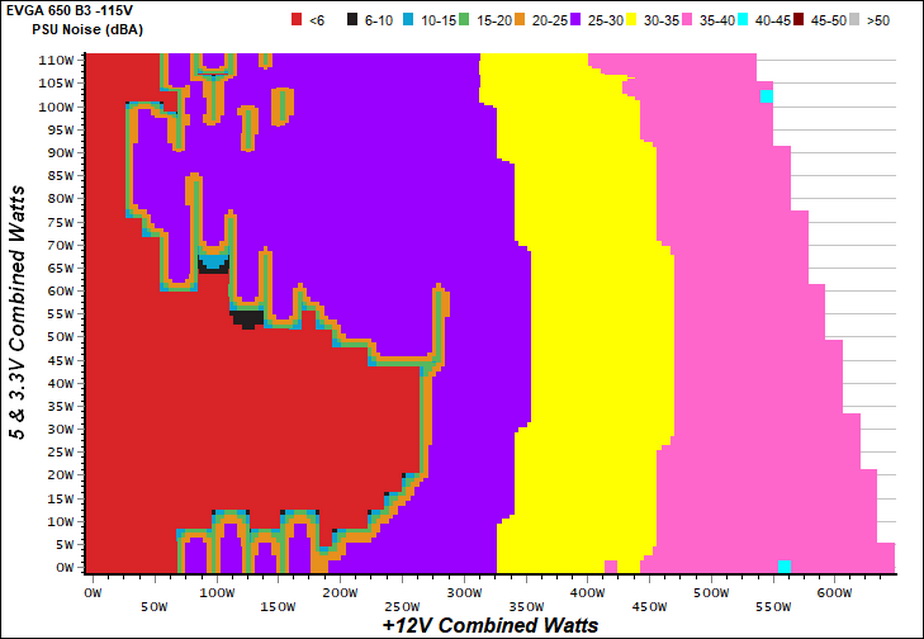EVGA 650 B3 PSU Review: No (Fixed) Cables Attached
Why you can trust Tom's Hardware
Efficiency, Temperature & Noise
Efficiency
Our efficiency testing procedure is detailed here.
Using results from the previous page, we plotted a chart showing the 650 B3’s efficiency at low loads, and loads from 10 to 110 percent of its maximum-rated capacity.
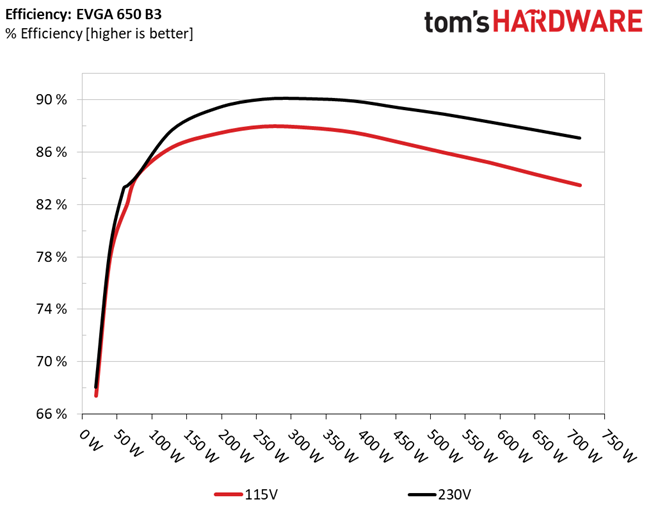
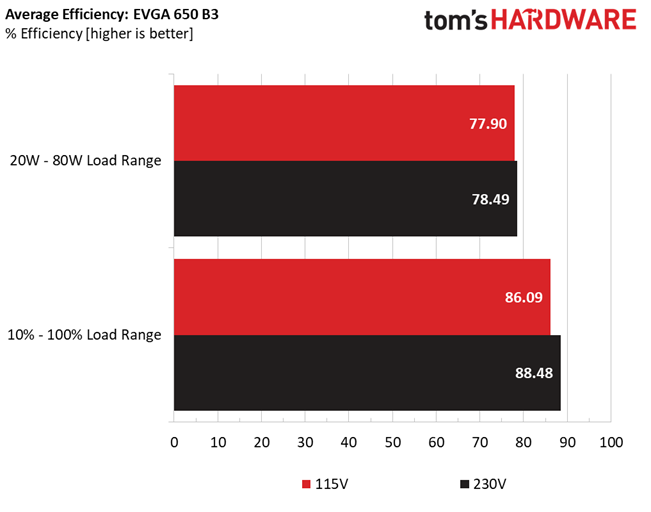
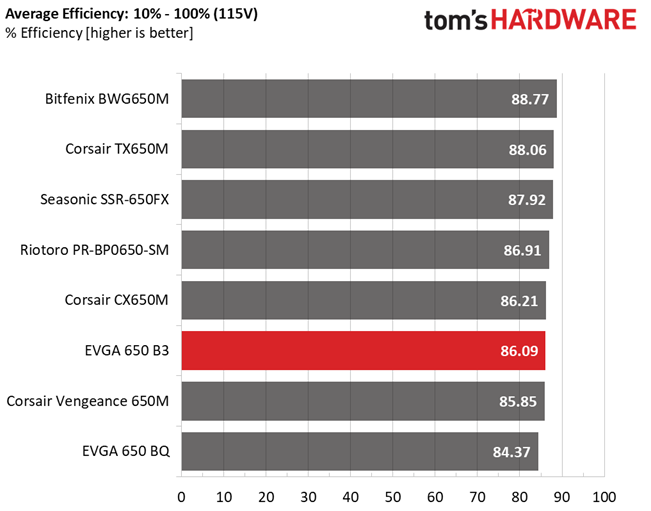

The CX650M and Riotoro Onyx 650 achieved higher efficiency under normal loads than EVGA's 650 B3. The 650 B3 did fare better under light loads. However, it still fell behind the Onyx 650, which is based on a Great Wall platform.
Efficiency At Low Loads
In the following tests, we measure the 650 B3's efficiency at loads significantly lower than 10 percent of its maximum capacity (the lowest load the 80 PLUS standard measures). The loads we dialed were 20, 40, 60, and 80W. This is important for representing when a PC is idle, with power-saving features turned on.
| Test # | 12V | 5V | 3.3V | 5VSB | DC/AC (Watts) | Efficiency | Fan Speed | Fan Noise | PF/AC Volts |
|---|---|---|---|---|---|---|---|---|---|
| 1 | 1.195A | 0.492A | 0.480A | 0.195A | 19.656 | 67.380% | 0 RPM | <6 dB(A) | 0.838 |
| 12.191V | 5.068V | 3.324V | 5.124V | 29.172 | 115.22V | ||||
| 2 | 2.418A | 0.981A | 0.990A | 0.391A | 39.717 | 77.905% | 0 RPM | <6 dB(A) | 0.909 |
| 12.183V | 5.066V | 3.323V | 5.113V | 50.981 | 115.21V | ||||
| 3 | 3.645A | 1.478A | 1.500A | 5.101A | 59.843 | 82.078% | 0 RPM | <6 dB(A) | 0.953 |
| 12.178V | 5.064V | 3.323V | 5.101V | 72.910 | 115.21V | ||||
| 4 | 4.862A | 1.976A | 1.985A | 0.785A | 79.773 | 84.254% | 0 RPM | <6 dB(A) | 0.965 |
| 12.172V | 5.062V | 3.322V | 5.091V | 94.681 | 115.21V |
With the semi-passive mode activated, the fan didn't spin under light loads (even at 36-39°C operating temperatures). Surprisingly, the 650 B3's efficiency levels were even fairly high.
5VSB Efficiency
The ATX specification, along with CEC, ErP Lot 3 2014 and ErP Lot 6 2010/2013, states that 5VSB standby supply efficiency should be as high as possible, recommending 75 percent or higher with 550mA, 1A, and 1.5A of load. The PSU should also achieve higher than 75% efficiency at 5VSB under full load, or with 3A if its max current output on this rail is higher than 3A.
We take six measurements: one each at 100, 250, 550, 1000, and 1500mA, and one with the full load the 5VSB rail can handle.
Get Tom's Hardware's best news and in-depth reviews, straight to your inbox.
| Test # | 5VSB | DC/AC (Watts) | Efficiency | PF/AC Volts |
|---|---|---|---|---|
| 1 | 0.101A | 0.519 | 68.200% | 0.080 |
| 5.132V | 0.761 | 115.17V | ||
| 2 | 0.251A | 1.288 | 74.365% | 0.166 |
| 5.126V | 1.732 | 115.17V | ||
| 3 | 0.542A | 2.770 | 76.689% | 0.271 |
| 5.115V | 3.612 | 115.17V | ||
| 4 | 1.002A | 5.106 | 77.752% | 0.349 |
| 5.098V | 6.567 | 115.17V | ||
| 5 | 1.501A | 7.624 | 77.939% | 0.391 |
| 5.079V | 9.782 | 115.18V | ||
| 6 | 3.001A | 15.053 | 76.114% | 0.447 |
| 5.016V | 19.777 | 115.18V |
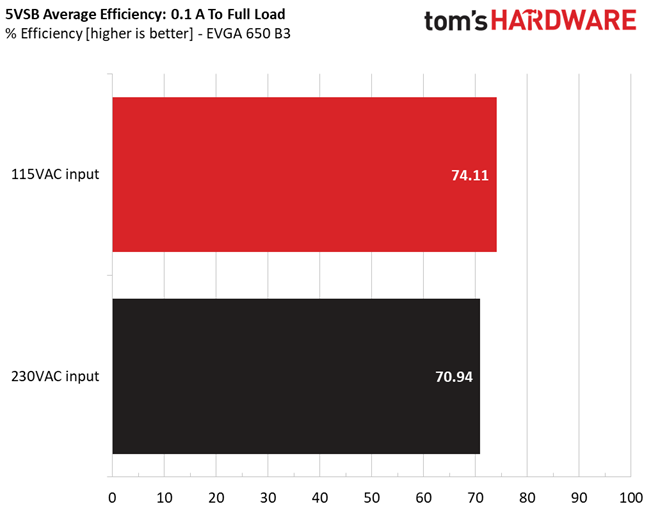
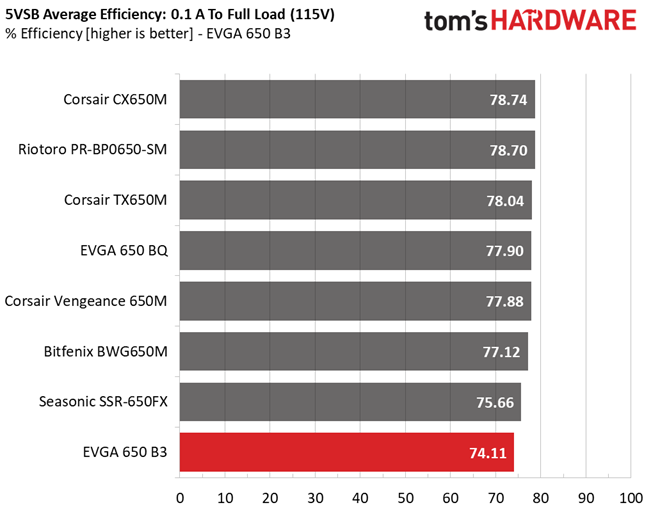
The 5VSB rail's efficiency was a huge let-down. This platform uses an outdated 5VSB circuit, which suffers from low efficiency and mediocre load regulation.
Power Consumption In Idle And Standby
In the table below, you'll find the power consumption and voltage values of all rails (except -12V) when the PSU is idle (powered on, but without any load on its rails), and the power consumption when the PSU is in standby mode (without any load, at 5VSB).
| Mode | 12V | 5V | 3.3V | 5VSB | Watts | PF/AC Volts |
|---|---|---|---|---|---|---|
| Idle | 12.206V | 5.070V | 3.325V | 5.135V | 7.565 | 0.460 |
| 115.2V | ||||||
| Standby | 0.128 | 0.014 | ||||
| 115.2V |

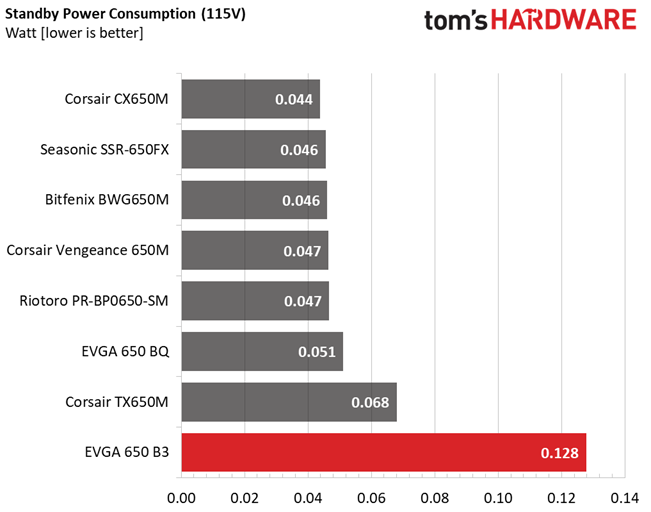
Measured vampire power was quite high compared to other platforms. This explains the 5VSB rail's low efficiency, especially under light loads.
Fan RPM, Delta Temperature, And Output Noise
Our mixed noise testing is described in detail here.
The first chart below illustrates the cooling fan's speed (in RPM), and the delta between input and output temperature. The results were obtained at 37°C (98.6°F) to 47°C (116.6°F) ambient temperature.
The next chart shows the cooling fan's speed (again, in RPM) and output noise. We measured acoustics from one meter away, inside a hemi-anechoic chamber. Background noise inside the chamber was below 6 dB(A) during testing (it's actually much lower, but our sound meter’s microphone hits its floor), and the results were obtained with the PSU operating at 37°C (98.6°F) to 47°C (116.6°F) ambient temperature.
The following graph illustrates the fan's output noise over the PSU's operating range. The same conditions of the above graph apply to our measurements, though the ambient temperature was between 30°C (86°F) to 32°C (89.6°F).
In order to avoid heat build-up inside of the PSU, its semi-passive mode wasn't allowed to last long. Noise output exceeded 30 dB(A) once the PSU was asked to deliver more than 320W load; above 440W loads, noise levels landed in the 35-40 dB(A) range.
MORE: Best Power Supplies
MORE: How We Test Power Supplies
MORE: All Power Supply Content
Current page: Efficiency, Temperature & Noise
Prev Page Load Regulation, Hold-Up Time & Inrush Current Next Page Protection Features
Aris Mpitziopoulos is a contributing editor at Tom's Hardware, covering PSUs.
-
logainofhades Definitely priced too high, when you can get a G3 650 for a similar cost.Reply
PCPartPicker part list / Price breakdown by merchant
Power Supply: EVGA - SuperNOVA G3 650W 80+ Gold Certified Fully-Modular ATX Power Supply ($69.99 @ Amazon)
Total: $69.99
Prices include shipping, taxes, and discounts when availableGenerated by PCPartPicker 2018-07-16 09:21 EDT-0400 -
redgarl Phhh, EVGA doesn't equal quality. My Supernova B3 blew up with my EVGA 1080 FTW because my 1080 FTW was defective and my other power supply prevented this whole fiasco.Reply
EVGA, never again, overated like Corsair! -
docswag Reply
G3 has similar issues to the B3 based off of Tom's reviews. I'd personally stay away from them.21146687 said:The B3 have known issues. The G2 and G3 are solid though.


